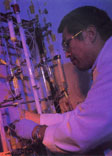  Wrench
in the machinery
Wrench
in the machinery
(continued)
Heyer,
educated in Germany and Switzerland, has played a major role in
the rapidly developing field. He has focused his research on DNA
repair in yeast, painstakingly identifying the individual genes
that are the nuts and bolts of the organism’s repair machinery,
then figuring out the jobs each one does. Because yeast and human
repair genes are so similar, despite the billion years of evolutionary
distance that separate them, knowledge gained in yeast experiments
can be applied directly to humans.
Of all the repair genes Heyer has studied, two have especially captured
his interest: Rad54 and Rad51. The two genes act as a team to repair
double-strand DNA breaks, one of the most complicated types of DNA
damage to fix. In a double-strand break, both of the parallel strands
of the DNA double helix are fractured.
Since 1997, Heyer has published 20 scientific papers on the two
repair genes, becoming a leading authority on Rad54 and Rad51. Normal
yeast with healthy versions of the two repair genes can survive
up to 50 double-strand DNA breaks. But if either repair gene gets
damaged, the yeast can’t handle even a single double-strand
break.
Double-strand DNA breaks are the precise type of damage cells suffer
when they are exposed to the radiation used in cancer treatment.
Some chemotherapy drugs also cause double-strand DNA breaks. If
Heyer can figure out a way to inhibit either or both of these repair
genes in cancer cells, fewer of the malignant cells will be able
to overcome the effects of radiation and chemotherapy. The cancers
will be easier to destroy.
Rad54 and Rad51 represent just two potential targets, as cells have
multiple ways to repair DNA damage. Blocking any of the key steps
in DNA repair should also leave cancer cells more vulnerable. Indeed,
Heyer says it may be necessary to inhibit multiple steps and multiple
pathways at the same time.
“Looking for ways to inhibit DNA repair in cancer cells will
be a growing part of our lab,” Heyer says. The ultimate goal
will be a pharmaceutical agent capable of shutting down DNA repair
in cancer cells, without impairing DNA repair in healthy tissue.
 

Home |
Table of Contents |
To our Readers |
Building on Basics
Focusing on Patients |
In Translation |
First Steps
Campus Connection |
Benefactors |
News in Brief
UC Davis Health System |
© 2000, 2001, 2002 UC Regents. All rights reserved.
|
 |



 
 Researcher Researcher
Xiao-Ping Zhang purifies the repair protein Rad51 in yeast.
|


 Researcher
Researcher